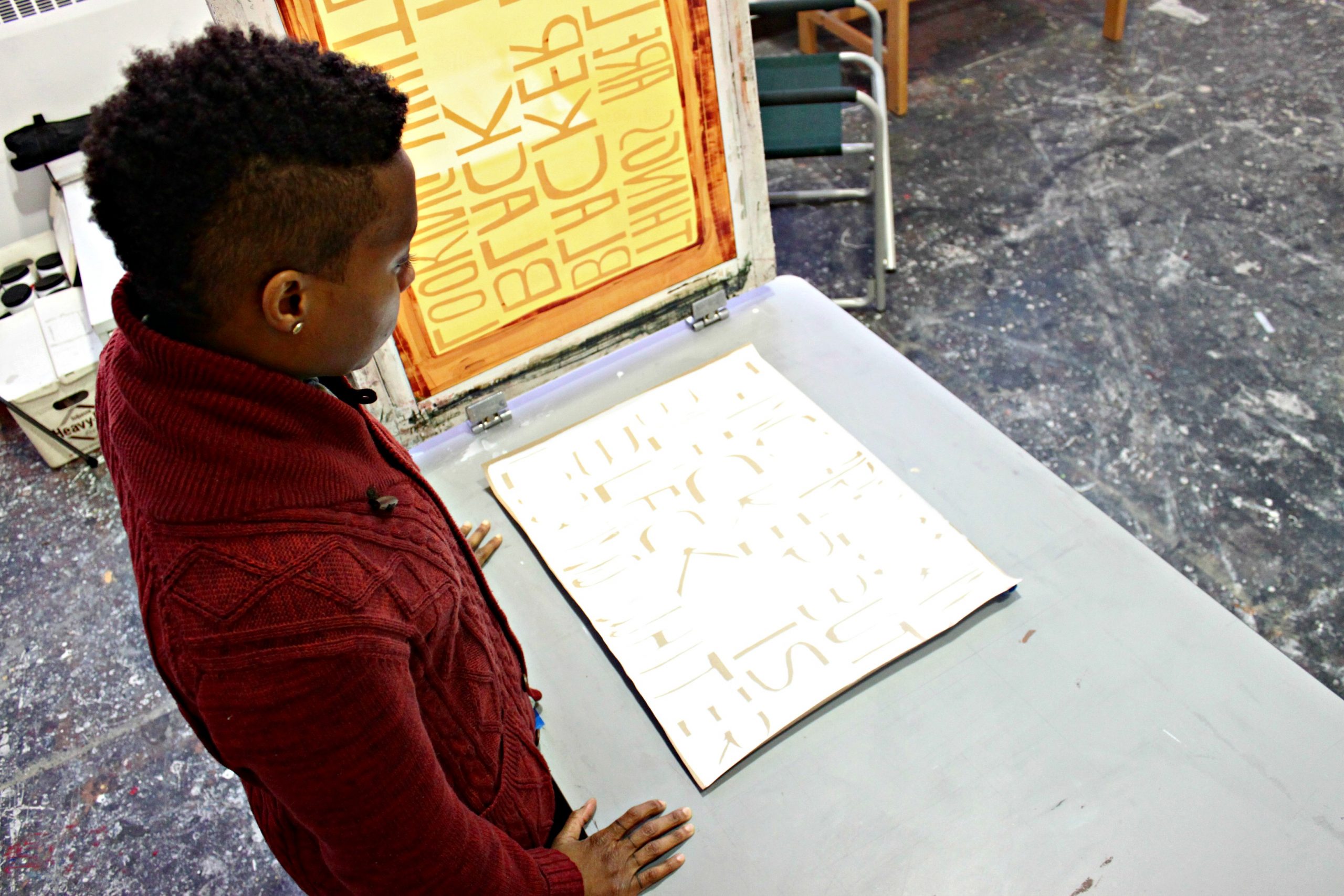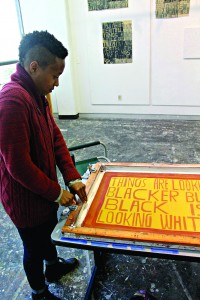
A short woman stands facing the wall of her studio. Sunlight beams through the elongated windows and illuminates a canvas that her attention is directed toward.
Paintbrush in hand, a determined look is on her face as she fills the text riddling her canvas with white paint. Ayanah Moor is hard at work, producing art for her upcoming three week showcase.
Moor is Georgia State’s first resident artist for its Arts and Humanities department, the result of a new program financed by Ernest G. Welch himself. Assistant Professor of Sculpture Ruth Stanford said Moor is perfect for the job.

Ayanah Moor prepares for her first exhibit at Georgia State.
“The school used its endowment from Ernest G. Welch to bring in scholars and artists from other parts of the country” Stanford said. “I thought she would be a great candidate. The diversity of work is interesting to young people, and I knew she would be a great Welch Scholar”.
Moor is an Associate Professor who is currently on a yearlong sabbatical, leaving Carnegie Mellon to spread her wealth of artistic knowledge. Stanford met and befriended Moor when she took Moor’s graduate seminar course at Carnegie Mellon University.
“She is smart and easy to talk to, and her availability to students makes her the perfect person for the job. She’s very approachable in student’s opinions”.
Moor is a visual artist who has multiple facets for her artistic talents, her most prominent focus being Printmaking, a concentration in which she has earned her bachelor’s and master’s degree. She is teaching a seminar class at Georgia State on the aesthetics of hip-hop while preparing for her show at the Welch art gallery.
“I’m interested in work that allows a space for viewers to interpret” Moor said. “Some people make art and have specific goals in mind. For me, my work has intention, but is also about viewers bringing personal experience to what they see. That’s why I use a lot of text. But it’s very rarely my own personal voice. You could describe it as appropriation.”

Ayanah Moor prepares for her first exhibit at Georgia State.
Moor’s Printmaking style involves writing bold quotations and ambiguous messages over blank canvases to evoke deep thought.
“I’m interested in challenging you to think on your own. There’s a dialogue within my work” Moor said. “I sample from various sources; sometimes they’re literary, sometimes they’re song lyrics. Then I represent the voice in my work. I don’t usually reveal the source in my work, because I don’t want it to be a distraction.”
Stanford confirms that Moor’s abstract style elicits a deeper meaning.
“The diversity of her art is very impressive,” Stanford said. “Her work all has a similar theme, but she approaches it from different angles. She has a youthful aesthetic and her work appeals to many scholars, from those interested in gender studies, to those involved with African American studies.”
Moor’s intriguing and captivating artistic style isn’t easily attained and she says she’s her own biggest critic.
“I’m pretty hard on myself” Moor said. “I’m always picking at my work to see what can be improved. I don’t think I have a favorite. There are aspects of my work I’m happy about, but there are also things I learn from my work that is unintentional.”
Moor also has strong opinions about the topic of art in university systems and believes that students she be careful before deciding to study art.
“Ask yourself if you want to work towards getting a degree in art” she said. “Figure out if it’s worthwhile investing in college to study your craft. I’m still paying back student loans to this day. School isn’t the only way to pursue your artistic career.”
Moor also said she feels that art doesn’t get enough reverence in university systems.
“I don’t think the arts a respected enough. Part of that is because we don’t always praise creativity. We don’t celebrate thinking differently enough. Universities should value the production of an artist just as much as they value the production of a researcher. Art contributes vastly to our culture”
Both Stanford and Moor said that they believe Georgia State students could learn a few things from studying Moor’s style while she is here.
“Her work ethic and scholarship is something that all Georgia State students can learn from” Stanford said. “Having relocated and being able to create a completely new body of work through all of the adjustments is impressive. There’s a high level of investigation that she puts into her work, and everyone can learn from that”.
Moor said that she believes young artists in Georgia State’s community can learn to become more independent and less fearful of expressing themselves.
“I would like young artists to trust their own voice more, and not look for their work to be praised by their elders as much. Sometimes it’s disheartening to hear students say they don’t know what to think about something, and always looking for a ‘right’ answer. I want younger artists to recognize their value, and express themselves accordingly“.
